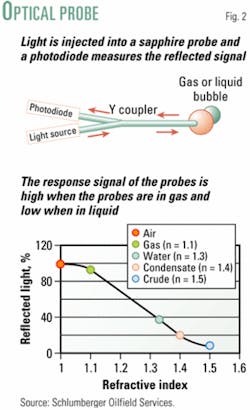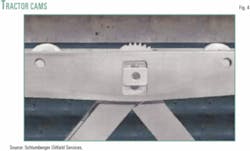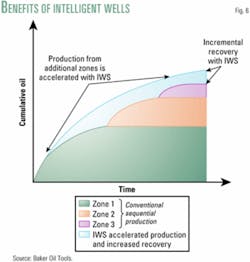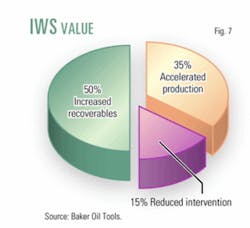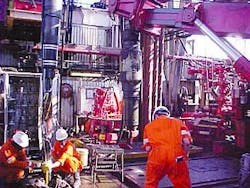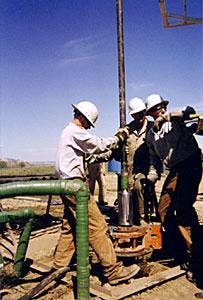Various new downhole technologies allow companies to optimize the production of petroleum resources from wells with more complex geometries and producing horizons that are in deeper water, coal beds, deeper and tighter formations, and accumulations containing heavier oil or bitumen.
These technologies include new production logging tools, intelligent completions, downhole pumps, expandable tubulars, frac fluids, and other completion technologies.
Production logs
Production logs collect data under dynamic conditions, so that an operator can determine the location and type of fluid entering the wellbore at various times during the life of a well. The logs also serve in diagnosing any mechanical problems with the wellbore such as scaling or casing corrosion.
For nearly vertical wells, production log interpretation of flow is relatively straightforward. Tools run include spinners to determine total flow velocity, single-point pressure and temperature measurements, and differential pressure measurements to establish fluid density, and capacitance meters to account for water hold-up. Flow in vertical wells typically is uniform across the wellbore.
But in deviated wells, the flow patterns become more complex, especially in wells producing multiphase fluids. Problems include low and high points in the wellbore that may cause fluids to stagnate and gravity segregation of fluid phases across the cross-section of a well.
Flow profiling in a horizontal wellbore requires tools to identify the cross-sectional area of each phase or hold-up and then to determine the velocity of each phase.
Traditional instruments for determining fluid density, such as a gradiomanometers, do not provide usable data in wells with greater than 60° deviation because the close spacing between the two ports in the tool results in both ports reading the same pressure.
The more complicated well geometries in nonvertical wells and the resulting complex flow regimes require new measurement tools for analyzing the oil, gas, and water phases.
To exemplify some of the tools now available, Fig. 1 shows tools offered by Schlumberger Oilfield Services.
The tools include a sonde for obtaining gamma ray and casing collar locator data for correlation, plus pressure and temperature measurements.
The flow-caliper imaging tool measures the average fluid velocity, water and hydrocarbon hold-ups, and bubble count from four independent probes. It also provides dual-axis X-Y caliper measurements and relative bearing measurements.
The bubble count image from the FloView hold-up measurement tool probes identifies the first fluid entry.
The gas hold-up optical sensor tool (GHOST) measures gas and liquid hold-ups with four sapphire optical probes (Fig. 2). These measurements discriminate between liquid and gas, improving three-phase flow rate determination.
The gradiomanometer is a specific gravity profile tool that measures the average density of the wellbore fluid, from which one can derive water, oil, and gas hold-ups.
Well deviation and accelerometer measurements provide the fluid density corrections that account for deviation.
The FloView tool has a second set of probes to measure water and hydrocarbon hold-ups and bubble counts. This information is useful in horizontal wells, where flow profiles are needed for analyzing surface production.
The in-line spinner provides a bidirectional fluid velocity measurement inside the tubing.
A crystal quartz gauge is another high-resolution pressure measurement tool, useful for providing data for pressure transient analysis.
The reservoir saturation tool (RST) offers sigma, carbon-oxygen, water flow, three-phase holdup, and spectrometry logging.
The slim-cement mapping tool (SCMT) indicates the soundness of the cement-to-casing bond and a cement map clearly idenfifies any channels in the bond.
Tractors
An operator can run production logging tools in many different combinations on an electric line with a surface readout or slicklines or coiled tubing with downhole memory. Also several venders can provide downhole tractors for conveying production logging tools downhole in highly deviated and horizontal holes.
For example, Schlumberger's recently developed tractor allows the toolstring to log while both tractoring into the hole and while being pulled out. Tool operators can monitor and control from the surface many tractor parameters such as motor current, motor torque, computed speed for each tractor section, cable-head tension, casing-collar location, deviation, and relative bearing.
The system's modular design allows tool operators to space multiple drive sections, up to four in tandem, to straddle diameter changes (2.4-9.625 in.) and washouts (Fig. 3).
Because the tractor logs while going down, it provides a look-ahead capability to identify and avoid problem areas, rather than run into them.
The tractor uses reciprocating-grip sections with cams, which act as mechanical amplifiers when gripping, that contact the wall at only three discrete points every 2 ft, thereby minimizing wellbore or formation damage and counteracting lift forces prevalent in high-flow-rate wells, according to Schlumberger (Fig. 4). The cams lock the toolstring in place even when the tool is stationary and high lift forces are trying to carry the tool and cable uphole.
Schlumberger says the arm linkage and cam design allow the cam to apply a constant radial force to the borehole wall, regardless of the well diameter..Because of this reciprocating design, the tractor can maneuver through diameter changes with greater ease than conventional systems can while pushing high loads and applying sufficient radial force to the wellbore so as not to slip.
The tractor depth limit is about 30,000-ft, based on cable strength. It has been designed to work in conditions up to 15,000 psi and temperatures of 302° F.
Intelligent completions
Intelligent completions provide the industry with a way to control and monitor downhole flow from the surface. These systems are especially useful in subsea completions and other wells with high intervention costs. Most intelligent well systems (IWS) to date include hydraulically actuated valves, although some installations are all electric.
Intelligent systems include permanent downhole sensors for measuring temperature, pressure, and flow. These sensors are mostly electric although fiber optic sensors are becoming an option.
Fiber optic measurements can provide continuous distributed temperature reading in a well bore at intervals of about 1 m, as shown in Fig. 5 for a steamflood well, and also discreet pressure and temperature readings.
Baker Oil Tools estimates that the industry now has 160 intelligent wells and that four vendors have more than a dozen installations each. In 2003, Baker says it doubled its number of intelligent completion system installations to 25. These include completions on land and in both platform and subsea wells.
It says, "Although installations in marginal land wells have been economically successful as well, the investment in intelligent well systems is more easily returned in a subsea scenario. Savings in avoided well intervention costs alone are generally sufficient to justify the investment (Fig. 6)."
It estimates that elimination of well intervention accounts for only 15% of the potential value of the technology (Fig. 7). The most value derived from this technology is from increased recoveries and accelerated production.
null
Baker recently installed its first deepwater all-electric intelligent completion in a Petrobras injection well in the Marlim Sul field (OGJ, Dec. 1, 2003, p. 48). This system remotely monitors the injection of 15,000-20,000 b/d of water into the 8-MLS-67HA-RJS well to determine the water distribution into two discrete intervals. Fig. 8 shows the running of the IWS in the offshore well.
In the Petrobras well, the system monitors real-time measurements of downhole pressure, temperature, and flow in both the tubing and annulus, so that the operator can manage injection in real time and selectively control individual zonal flow rates. This allows continuous well optimization in response to changing downhole conditions.
Other intelligent completion applications answer other needs. For example, Norsk Hydro AS, in the North Sea, uses a hydraulically operated, large-bore, gas-lift valve with multiple orifices that it can adjust remotely from the surface to control gas-cap gas for lifting fluids from deeper reservoirs.
The system allows Norsk Hydro to modify the valve settings as reservoir conditions change without the need for subsea well intervention.
Coal beds
Dewatering of coalbed methane wells has also spurred some new more economic and efficient artificial-lift methods. For instance, Weatherford Inc. indicates that one problem in dewatering coalbeds with convention submersible pumps has been that the pumps experience poor performance and a short life as the water rate decreases and gas production increases. Also coal particles can erode the pumps as well as plug them.
To counter these problems, Weatherford designed its coalbed methane-electric submersible pump (CBM-ESP) to work at deep or shallow depths, with low or high water volumes, and in a wide range of pressures and temperatures.
Weatherford manufactures the pumps with different shroud configurations to handle gassy fluids.
The shrouds divert gas from around the pump and allow it to flow up the wellbore.
The pump utilizes compression stages to help with low fluid-producing wells and intake screens to divert abrasive fines from the intake.
Weatherford says that in the Powder River basin, which has more than 9,500 wells, operators using water-well pumps with mostly plastic parts experience 27-day run times compared to the 120-day run average of its CBM-ESPs.
null
Another technology being installed in coalbed methane wells is a tool that separates gas and water downhole (Fig. 9) . The VX tool manufacturer, VortexFlow, Houston, says the tool has improved production of water and gas from various formations, such as the Green River and Powder River basins in Wyoming, and the San Juan basin in Colorado and New Mexico.
As an example, in one Powder River basin 623-ft deep coalbed methane well VortexFlow says the downhole VX tool replaced a progressing-cavity pump and increased both gas and water production.
It says prior to the installation of the tools, the well produced 180 Mcfd and 60 bw/d, but 14 weeks after the VX this well continues to flow effectively without needing electricity or pump maintenance.
Fracturing advances
More environmentally friendly fluids are continuing to enter the market. For instance, Baker Oil Tools now offers a high performance, low toxicity, and biodegradable fracturing fluid (B9 Emerald FRAQ) that it says is ideal for offshore use. It describes the system as having a basic guar polymer similar to the viscosifying agent for foods such as hot sauces and ice creams.
The fluid has less than a 29 mg/l. oil and grease content, and therefore, exceeds the US Code of Federal Regulations (CFR 40 Part 435) standards for the permitted discharge of oil and gas-free well treating fluids. Baker Oil Tools also says that the fluid's low toxicity (less than 3%) satisfies federal limits set for drilling fluids that do not apply to well-treatment fluids. The fluid is biodegradable to greater than 60% in 28 days.
The fluid also includes a new BeakBAQ breaker based on readily available chemicals found in everyday lives.
Baker Oil Tools says the fluid substantially reduces the environmental impact of frac-pack completions and also allows operation to discharge fluid under the well's site-specific discharge permit, thereby reducing disposal costs and risks associated with handling and transporting fluids.
It says Apache Corp. has used the fluid in three Gulf of Mexico frac-pack completions, with excellent results.
Expandables
Expandable tubulars are changing the way wells are completed. Enventure Global Technology, the largest seller of expandables, recently announced that in 2003 it had run expandables in 93 installations and expanded 98,050 ft of pipe.
During the year it added two new applications: a window exit and cladding that allows the expandable tubulars to set directly against a formation without cementing.
By yearend 2003, it says it had installed a cumulative 208 systems and expanded 205,610 ft of pipe.
It describes the window exit installation as involving expanding an openhole liner below the window, allowing the operator to maintain hole size to total depth. This capability increases the range of applications for the OHL System in sidetracks in existing casing.
In three wells, Enventure installed tubulars that were designed and sized to clad directly against the formation, so that the expansion produced a robust seal against the formation making primary or remedial cementing unnecessary.
Other vendors manufacture expandable tubulars that serve as liner hangers, expandable sand screens, and cladding to repair casing, and shut off water and gas in cased hole.
Monobore completions
This year Baker Oil Tools introduced the first completion system developed specifically for cemented monobore wells, the Mono-Trip CemenThru completion system. It ran its first test during fall 2003 in the Gulf of Thailand.
Baker Oil Tools says the system adds artificial-lift capability and improves safety for cemented monobore wells. Components include a side-pocket gas lift mandrel, a tubing-retrievable surface controlled subsurface valve (TRSCSSV), and a hydrostatic circulating valve. Other components are a hydraulically set liner-top packer, a dual wiper plug, and a latch collar.
Baker Oil Tools indicates that operators are completing a growing percentage of short-life wells, which produce for only 3-5 years, as cemented monobores. It says such wells are common in the Gulf of Thailand and are prevalent throughout the Asia Pacific region, and the concept is also growing in popularity in Canada and in the Gulf of Mexico.
The wells are completed in a single trip by running a tubing hanger and a single tubing-string and then cementing through the tubing-string and up the annulus. Before its system, Baker Oil Tools says the cement-through completion process precluded the use of packers or positive seals. Also, because standard gas-lift devices do not permit cement-through operations, cemented monobore wells have had no proven method for artificial lift as production decreased.
Its completion system has a patented side-pocket gas lift mandrel that contains internal supports and vanes in the mandrel to disrupt fluid flow during cement operations, thus creating turbulent flow conditions that cause the cement to swirl and prevent it from building up on the fishing neck.
The vanes also guide cement wiper plugs through the mandrel and deflect inappropriate running or pulling tools away from the pocket.
Other components include a tubing-retrievable surface-controlled subsurface safety valve that includes through-the-flapper equalizing, a wireline-resistant flapper, and puncture communication technology. Also, an annular piston isolates the spring cavity from wellbore fluids and cement, and the flow tube excludes fluids from the flapper cavity during installation and production. The system also includes a new hydrostatic circulating valve, a hydraulically set liner-top packer, dual wiper plugs, and a latch collar.
After landing the completion and setting the packer, completion personnel open the circulating valve via a burst disc so that excess cement can be circulated out.
Pressure applied across the annular sleeve shifts the valve downward, closing off the ports. A redundant internal insert provides a secondary means of sealing the tubing from the annulus.


